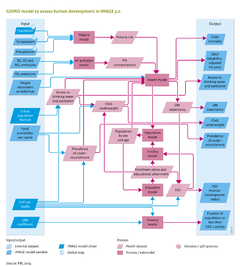Human development/Description: Difference between revisions
Jump to navigation
Jump to search
No edit summary |
No edit summary |
||
| Line 10: | Line 10: | ||
This module describes the causal chains between health-risk factors and health outcomes (morbidity and mortality) and takes into account the effect of health services. The mortality rate is modelled by a risk-factor-attributable component and a non-attributable component. Historically, the non-attributable component represents mortality not covered by the risk factors included. For future projections, this component is assumed to reduce by the average regional historical rates of reduction. | This module describes the causal chains between health-risk factors and health outcomes (morbidity and mortality) and takes into account the effect of health services. The mortality rate is modelled by a risk-factor-attributable component and a non-attributable component. Historically, the non-attributable component represents mortality not covered by the risk factors included. For future projections, this component is assumed to reduce by the average regional historical rates of reduction. | ||
The risk-factor-attributable component is based on a multi-state approach that distinguishes exposure, disease and death ([[WHO, 2002]]; [[Cairncross and Valdmanis, 2006]]). This implies that incidence and case fatality rates (ratio of the number of deaths from a specific disease to the number of diagnosed cases) are taken into account for various health-risk factors. Case fatality rates are modified by the level of health services. This method is used for malaria, diarrhoea and pneumonia. The method for projecting mortality due to other causes (non-communicable chronic diseases, other communicable diseases and injuries) follows the global burden of disease ({ | The risk-factor-attributable component is based on a multi-state approach that distinguishes exposure, disease and death ([[WHO, 2002]]; [[Cairncross and Valdmanis, 2006]]). This implies that incidence and case fatality rates (ratio of the number of deaths from a specific disease to the number of diagnosed cases) are taken into account for various health-risk factors. Case fatality rates are modified by the level of health services. This method is used for malaria, diarrhoea and pneumonia. The method for projecting mortality due to other causes (non-communicable chronic diseases, other communicable diseases and injuries) follows the global burden of disease ({{abbrTemplate|GBD}}) approach. This method uses a parsimonious regression technique to relate mortality rates with GDP, smoking behaviour and human capital, in ten major disease clusters ([[Mathers and Loncar, 2006]]). This method is also used in determining death related to urban air pollution. | ||
<div class="thumbcaption dark">Table: Cause of death and environmental risk factors </div> | <div class="thumbcaption dark">Table: Cause of death and environmental risk factors </div> | ||
| Line 23: | Line 23: | ||
</tr> | </tr> | ||
<tr> | <tr> | ||
<td>Protein deficiency</td> | <td>Protein deficiency | ||
<td>Prevalence of underweight</td> | </td> | ||
<td>Prevalence of underweight | |||
</td> | |||
</tr> | </tr> | ||
<tr> | <tr> | ||
<tr> | <tr> | ||
<td>Diarrhoea</td> | <td>Diarrhoea | ||
<td>Lack of safe drinking water and basic sanitation</td> | </td> | ||
<td>Lack of safe drinking water and basic sanitation | |||
</td> | |||
</tr> | </tr> | ||
<td>Pneumonia, Chronic obstructive pulmonary disease (COPD), Lung cancer</td> | <td>Pneumonia, Chronic obstructive pulmonary disease (COPD), Lung cancer | ||
<td>Use of solid fuels (traditional biomass or coal) for cooking and heating</td> | </td> | ||
<td>Use of solid fuels (traditional biomass or coal) for cooking and heating | |||
</td> | |||
</tr> | </tr> | ||
<tr> | <tr> | ||
<td>Lung cancer, Cardiopulmonary diseases, Acute respiratory infections (ARI)</td> | <td>Lung cancer, Cardiopulmonary diseases, Acute respiratory infections (ARI) | ||
</td> | |||
<td>Exposure to PM10 and PM2.5, related to NOx, SO2 and black carbon emissions | <td>Exposure to PM10 and PM2.5, related to NOx, SO2 and black carbon emissions | ||
</td> | </td> | ||
Revision as of 08:34, 20 May 2014
Parts of Human development/Description
| Component is implemented in: |
|
| Related IMAGE components |
| Projects/Applications |
| Models/Databases |
| Key publications |
| References |
